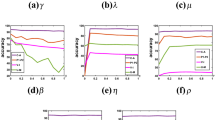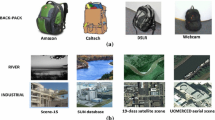Abstract
Transfer learning and domain adaptation are promising solutions to solve the problem that the training set (source domain) and the test set (target domain) follow different distributions. In this paper, we investigate the unsupervised domain adaptation in which the target samples are unlabeled whereas the source domain is fully labeled. We find distinct transformation matrices to transfer both the source and the target domains into the disjointed subspaces where the distribution of each target sample in the transformed space is similar to the source samples. Moreover, the marginal and conditional probability disparities are minimized across the transformed source and target domains via a non-parametric criterion, i.e., maximum mean discrepancy. Therefore, different classes in the source domain are discriminated using the between-class maximization and within-class minimization. In addition, the local information of the source and target data including geometrical structures of the data are preserved via sample labels. The performance of the proposed method is verified using various visual benchmarks experiments. The average accuracy of our proposed method on three standard benchmarks is 70.63%. We compared our method against other state-of-the-art domain adaptation methods where the results prove that it outperforms other domain adaptation methods with 22.9% improvement.






Similar content being viewed by others
References
Patel, V.M., Gopalan, R., Li, R., Chellappa, R.: Visual domain adaptation: a survey of recent advances. IEEE Signal Process Mag. 32(3), 53–69 (2015)
Pan, S.J., Yang, Q.: A survey on transfer learning. IEEE Trans. Knowl. Data Eng. 22(10), 1345–1359 (2010)
Shao, L., Zhu, F., Li, X.: Transfer learning for visual categorization: a survey. IEEE Trans. Neural Netw. Learn. Syst. 26(5), 1019–1034 (2015)
Weiss, K., Khoshgoftaar, T.M., Wang, D.: A survey of transfer learning. J. Big Data 3(1), 9 (2016)
Luo, L., Chen, L., Hu, S., Lu, Y., Wang, X.: Discriminative and geometry aware unsupervised domain adaptation. arXiv:1712.10042 (2017) (preprint)
Jing, M., Li, J., Zhao, J., Lu, K.: Learning distribution-matched landmarks for unsupervised domain adaptation. In: International conference on database systems for advanced applications, pp. 491–508. Springer, Cham (2018)
Li, S., Song, S., Huang, G., Ding, Z., Wu, C.: Domain invariant and class discriminative feature learning for visual domain adaptation. IEEE Trans. Image Process. 27(9), 4260–4273 (2018)
Gretton, A., Borgwardt, K.M., Rasch, M.J., Schölkopf, B., Smola, A.: A kernel two-sample test. J. Mach. Learn. Res. 13(Mar), 723–773 (2012)
Tahmoresnezhad, J., Hashemi, S.: A generalized kernel-based random k-samplesets method for transfer learning. Iran. J. Sci. Technol. Trans. Electr. Eng. 39, 193–207 (2015)
Tahmoresnezhad, J., Hashemi, S.: Visual domain adaptation via transfer feature learning. Knowl. Inf. Syst. 50(2), 585–605 (2017)
Xu, Y., Fang, X., Wu, J., Li, X., Zhang, D.: Discriminative transfer subspace learning via low-rank and sparse representation. IEEE Trans. Image Process. 25(2), 850–863 (2016)
Luo, L., Wang, X., Hu, S., Wang, C., Tang, Y., Chen, L.: Close yet distinctive domain adaptation. arXiv:1704.04235 (2017) (preprint)
Luo, L., Wang, X., Hu, S., Chen, L.: Robust data geometric structure aligned close yet discriminative domain adaptation. arXiv:1705.08620 (2017) (preprint)
Liu, J., Li, J., Lu, K.: Coupled local-global adaptation for multi-source transfer learning. Neurocomputing 275, 247–254 (2018)
Tahmoresnezhad, J., Hashemi, S.: Exploiting kernel-based feature weighting and instance clustering to transfer knowledge across domains. Turk. J. Electr. Eng. Comput. Sci. 25(1), 292–307 (2017)
Ding, Z., Fu, Y.: Robust transfer metric learning for image classification. IEEE Trans. Image Process. 26(2), 660–670 (2017)
Zhang, J., Li, W., Ogunbona, P.: Joint geometrical and statistical alignment for visual domain adaptation. arXiv:1705.05498 (2017) (preprint)
Sun, B., Saenko, K.: Subspace distribution alignment for unsupervised domain adaptation. In: BMVC (pp. 24-1) (2015)
Shao, M., Kit, D., Fu, Y.: Generalized transfer subspace learning through low-rank constraint. Int. J. Comput. Vis. 109(1–2), 74–93 (2014)
Jolliffe, I.: Principal component analysis. In: International encyclopedia of statistical science (pp. 1094–1096). Springer, Berlin (2011)
Cover, T., Hart, P.: Nearest neighbor pattern classification. IEEE Trans. Inf. Theory 13(1), 21–27 (1967)
Li, W., Zhang, Z., Liu, Z.: Action recognition based on a bag of 3D points. In: Proc. IEEE Computer Society Conference on Computer Vision and Pattern Recognition Workshops. IEEE (2010), pp. 9–14
Belkin, M., Niyogi, P., Sindhwani, V.: Manifold regularization: a geometric framework for learning from labeled and unlabeled examples. J. Mach. Learn. Res. 7, 2399–2434 (2006)
Long, M., Wang, J., Ding, G., Sun, J., Philip, S.Y.: Transfer feature learning with joint distribution adaptation. In: IEEE International Conference on Computer Vision (ICCV), 2013, pp. 2200–2207 (2013)
Saenko, K., Kulis, B., Fritz, M., Darrell, T.: Adapting visual category models to new domains. In: European Conference on Computer Vision, pp. 213–226. Springer, Berlin (2010)
Griffin, G., Holub, A., Perona, P.: Caltech-256 object category dataset (2007)
Saenko, K., Kulis, B., Fritz, M., Darrell, T.: Adapting visual category models to new domains. In: Proceedings of the European Conference on Computer Vision, pp. 213–226 (2010)
Sim, T., Baker, S., Bsat, M.: The CMU pose, illumination, and expression (PIE) database. In: Fifth IEEE International Conference on Automatic Face and Gesture Recognition, 2002, Proceedings, pp. 53–58 (2002)
Lecun, Y., Botton, L., Bengio, Y., Haffner, P.: Gradient based learning applied to document recognition. Proc. IEEE 86(11), 2278–2324 (1998)
Hull, J.: A database for handwritten text recognition research. IEEE Trans. Pattern Anal. Mach. Intell. 16(5), 550–554 (1994)
Fernando, B., Habrard, A., Sebban, M., Tuytelaars, T.: Unsupervised visual domain adaptation using subspace alignment. In: Proceedings of the IEEE International Conference On Computer Vision, pp. 2960–2967 (2013)
Long, M., Wang, J., Ding, G., Sun, J., Yu, P.S.: Transfer joint matching for unsupervised domain adaptation. In: Proceedings of the IEEE Conference on Computer Vision and Pattern Recognition, pp. 1410–1417 (2014)
Author information
Authors and Affiliations
Corresponding author
Additional information
Publisher's Note
Springer Nature remains neutral with regard to jurisdictional claims in published maps and institutional affiliations.
Rights and permissions
About this article
Cite this article
Rezaei, S., Tahmoresnezhad, J. Discriminative and domain invariant subspace alignment for visual tasks. Iran J Comput Sci 2, 219–230 (2019). https://doi.org/10.1007/s42044-019-00037-y
Received:
Accepted:
Published:
Issue Date:
DOI: https://doi.org/10.1007/s42044-019-00037-y




